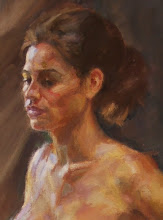 How we see the art world is very much influenced by the commentators:
How we see the art world is very much influenced by the commentators:The art historians, the art critics etc.
The term art historian carries with it an implied degree of knowledge about the quality of art. However, although they may have the best of intentions it is quite possible for an art historian to learn all the dates and movements etc, but be unable to acquire the necessary ability to access quality. Often the claims made about many art historians understanding of art or painting are not always justified. Commentators in other disciplines such as music, maths or tennis are usually exponents in that particular field. In fact it would be unthinkable to have a commentator in maths who was not a very considerable exponent. Reading between the lines it soon becomes evident that many art historians understanding of art is flawed. Before we deal with this in any depth, it is often expedient for artists to go along with the writings of commentators, in fact it would not be an exaggeration to say that artists careers are made by a certain symbiosis. Each giving the other what is required to drive the market, this is fine when both are in a reified atmosphere, the realms of genius. My concern is that the recent past has seen a rise in the less visually literate becoming involved in the arts. As often or not it seems more like the blind leading the blind, beginning with that transition period known as the Modernists. That period from the late 19th century to the early 20th century. The question is, is it now time for a review of this period? Hind sight is never a bad thing, is it now time to say that some of the information that we were fed was not always correct. I know from my own experience that some of the information from Art College was not factually correct. Coincidently I saw the same information repeated recently on a TV documentary on art i.e. that the some what strange sinewy images painted by Cimabue where done in this fashion out of choice. The art historian on the documentary made a point of saying that Cimabue could quite easily have painted a more representational image. This a fundamental flaw in the art historians understanding of the painter. The art historian continued with how wonderful the eyes were in the Byzantine paintings and he reasoned that they had been painted in this way to seem elemental and filled with awe. Art historians often have the idea that if someone is called an artist they are automatically granted a God given talent, that they can paint like Michael Angelo and that any divergence from this is through choice and certainly not through lack of ability, they seem to misconstrue sheer inability for design. Byzantine work can be considered analogous to a childs attempt at producing a picture. They both confuse symbols with vision. Nicely illustrated in Ernst Gombrich’s book Art and Illusion, where another art historian, this time a much celebrated art historian, suffers from a more dramatic example of this misunderstanding.
When a child draws mummy as a round head with eyes, nose and mouth and strands of hair, a triangle for a dress with two arms and two legs sticking out, this is a symbolic illustration of the child's perception, the child perceives the mummy and draws a symbol for that perception.



No comments:
Post a Comment